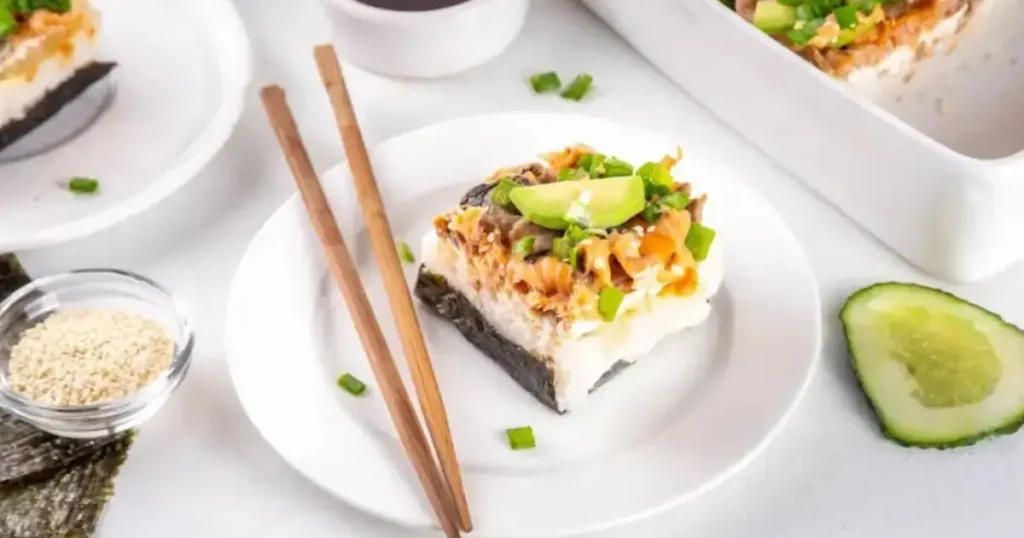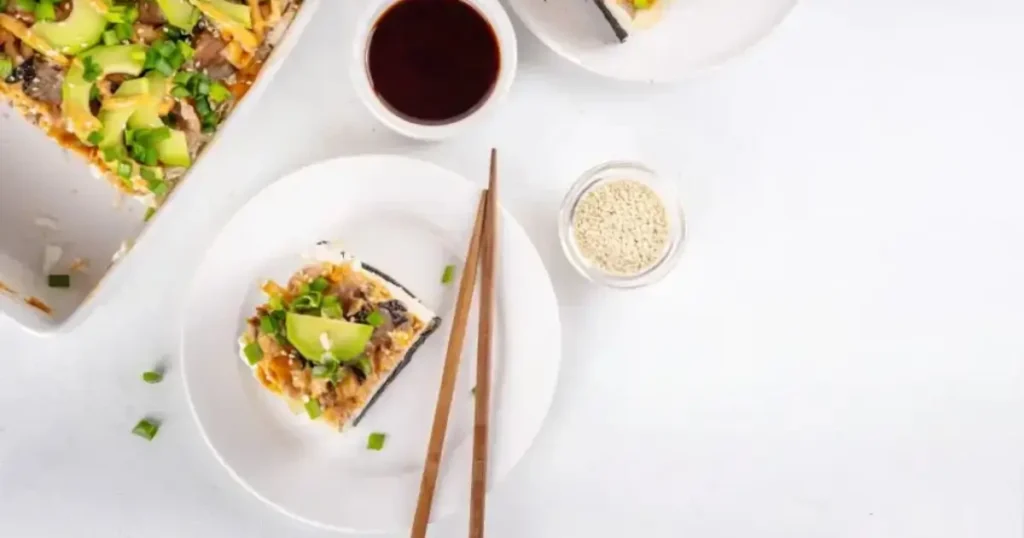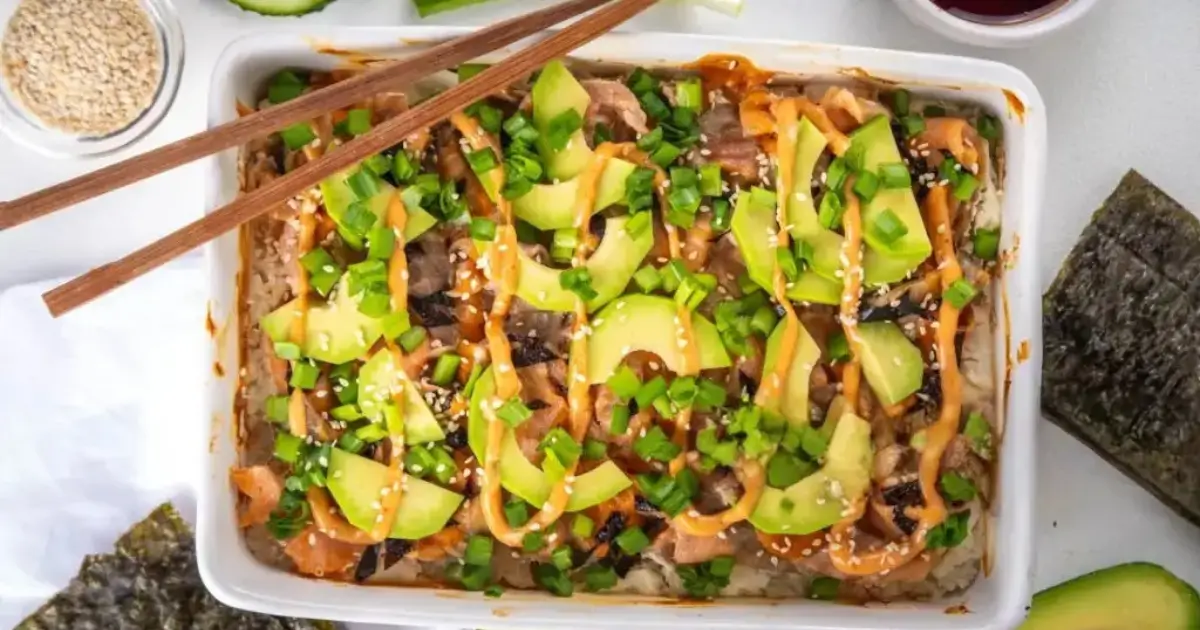Table of Contents
Seeking a delightful and hassle-free method to savor sushi at home? sushi casserole salmon emerges as the quintessential solution. It harmoniously blends the quintessential sushi flavors with the convenience of a casserole. This dish’s adaptability makes it ideal for family gatherings or impressing friends at social events. This article delves into strategies to enhance your sushi salmon bake journey, ensuring the creation of delectable dishes that foster communal dining experiences.
Key Takeaways
- Sushi bake offers a simple and enjoyable cooking experience.
- Utilizing sushi casserole salmon makes this dish both flavorful and filling.
- This versatile recipe can accommodate various ingredients based on your preferences.
- Sushi salmon bake is perfect for weeknight dinners or special occasions.
- Elevate your gatherings with this crowd-pleasing comfort food.
Understanding Sushi Bake: What It Is and Why You Should Try It
Sushi bake is a contemporary reinterpretation of traditional sushi, presented in a casserole format. This innovation caters to both sushi connoisseurs and novices, offering a blend of fresh ingredients and rich umami flavors. The result is a dish that is both warming and deeply satisfying.
The genesis of sushi bake lies in the culinary world’s quest to simplify sushi preparation. By eschewing the intricate art of sushi rolling, one can create a casserole-style sushi dish. This method obviates the need for advanced rolling techniques, making sushi accessible to all.
There are compelling reasons to explore sushi bake. Its ease of preparation stands out, allowing for a quick yet flavorful meal. Ideal for both social gatherings and intimate family dinners, sushi bake’s warm, layered textures are particularly appealing during the colder seasons. For those desiring a straightforward yet delectable sushi experience, sushi bake emerges as a compelling option.
In conclusion, sushi bake is an excellent choice for anyone looking to impress or simply enjoy a comforting meal at home. It offers a fresh perspective on a timeless favorite, showcasing the season’s finest ingredients in a modern, accessible format.
The Benefits of Making Sushi Casserole at Home
Creating a sushi casserole at home presents numerous advantages. This homemade dish’s versatility allows you to select your preferred ingredients. You can tailor flavors and textures to align with your taste preferences. Options range from fresh seafood and vegetables to vegetarian alternatives, catering to diverse palates.
Cost-effectiveness is another significant benefit. Preparing sushi bake at home is generally more economical than purchasing takeout. By purchasing ingredients in bulk, you can craft a meal that pleases your palate without financial strain.
Accommodating various dietary restrictions is also feasible when preparing sushi casserole at home. Whether you follow a gluten-free, vegan, or specific allergen-free diet, you have full control over your dish’s composition. This flexibility not only fosters healthier eating habits but also ensures the meal’s enjoyment for all.
The practicality of leftovers further enhances the dish’s appeal. Sushi casserole can be stored and reheated for quick meals throughout the week. This feature makes it an ideal choice for meal prep, providing a convenient solution for daily meals without the need for constant cooking.
Essential Ingredients for Your Sushi Bake
To craft a delectable sushi casserole, it is crucial to choose the right components. The selection of essential ingredients for sushi bake is pivotal in achieving authentic flavors and textures, particularly when preparing a sushi casserole salmon. Focus on fresh seafood, quality condiments, and the perfect rice to elevate your dish.
Key Components for Delicious Sushi Casserole Salmon
For a remarkable sushi casserole salmon, the following ingredients are imperative:
- Fresh or Cooked Salmon: Opt for high-quality, sushi-grade salmon for superior taste. If opting for cooked salmon, ensure it is flaky and retains moisture.
- Cream Cheese: This ingredient adds a creamy texture and rich flavor, balancing the dish’s overall composition.
- Nori Sheets: Essential for that authentic sushi taste, cutting these into strips and incorporating them lends depth to the casserole.
- Vegetables: Add color and crunch with ingredients like cucumbers, avocado, and scallions, enhancing both flavor and presentation.
- Spices and Sauces: Wasabi, soy sauce, and sriracha can elevate the dish’s taste, providing a kick to every bite.
Choosing the Right Type of Rice
The foundation of your sushi bake heavily relies on the type of rice used. For best results, consider these options:
| Type of Rice | Texture | Flavor Profile | Ideal Uses |
| Short-Grain Rice | Sticky and chewy | Mild and slightly sweet | Perfect for sushi bakes and sushi rolls |
| Sushi Rice | Firm but tender | Neutral, absorbs flavors well | Best for traditional sushi preparations |
Utilizing short-grain or sushi rice ensures that your sushi bake holds together and provides the ideal texture for a satisfying sushi casserole salmon. Properly rinse and cook the rice for optimal results, contributing to the overall success of your dish.
Sushi Bake Recipe: Salmon and Crab Variations
Embarking on the journey to craft a sushi bake recipe featuring salmon and crab is a deeply rewarding endeavor. This creation marries the opulent essence of salmon with the succulent sweetness of crab, thereby becoming a favorite among both family and friends. The following recipe serves as a comprehensive guide, ensuring a seamless path to preparing this delectable casserole.
- Preheat your oven to 350°F (175°C).
- Initiate the rice preparation by rinsing it under cold water until the water runs clear. Then, cook it according to the package instructions until it reaches a fluffy consistency.
- In a separate bowl, combine cream cheese, mayonnaise, and a measured amount of soy sauce to create a luscious base.
- Mix in flaked salmon and chopped crab meat, ensuring a uniform distribution.
- Layer half of the cooked rice in a baking dish, followed by the seafood mixture, and conclude with the remaining rice.
- Enhance the dish with a sprinkle of furikake seasoning and shredded nori for added depth of flavor.
- Place the dish in the preheated oven and bake for 20-25 minutes, or until it is heated through and the top is golden.
Consider topping your sushi bake with sliced fresh avocado and a sprinkle of chopped green onions before serving. These garnishes not only elevate the dish’s visual appeal but also introduce a refreshing element to your sushi bake recipe.
Additional Tips for Your Sushi Bake
- Experiment with different seafood options; shrimp or imitation crab can be excellent alternatives.
- Customize the creaminess by adjusting the mayonnaise and cream cheese quantities.
- Complement your sushi bake with soy sauce or a spicy mayo for an added layer of flavor.
This sushi casserole salmon, featuring salmon and crab, presents a versatile canvas for exploring diverse flavors and textures within the realm of a classic dish. Embark on this culinary journey, and you will soon discover it becoming a cherished staple in your repertoire of recipes.
Steps to Prepare Your Sushi Bake Easily
Embarking on the journey to prepare sushi bake can be a delightful adventure, requiring only a few straightforward steps. By concentrating on the most critical tasks, you can achieve a delectable outcome. Adhering to these steps will transform your home cooking, making it a rewarding endeavor. To ensure a seamless and pleasurable cooking experience, consider these preparation tips.
Preparation Tips for a Smooth Cooking Process
- Preheat your oven to 350°F to ensure it reaches the ideal temperature for baking.
- Gather all your ingredients beforehand, including rice, toppings, and sauces.
- Prepare the rice as per the instructions, making sure it has the right texture for a sushi bake easy preparation.
- When layering your ingredients, start with rice, followed by seafood and a generous amount of toppings.
- For convenience, consider preparing your sushi bake a day ahead. Refrigerate the assembled dish and bake it fresh when ready to serve.
- Test the sushi bake for doneness by checking for a golden-brown top before removing it from the oven.
By adhering to these steps, you can master the art of sushi bake preparation. Each step, though small, plays a crucial role in crafting a dish that will surely impress your loved ones.
Sharing Your Sushi Bake: Ideal Serving Suggestions
Presenting your sushi casserole salmon in an enticing manner can significantly enhance the dining experience. Serving it with complementary sides that highlight the flavors is advisable. Miso soup and a simple green salad are exemplary choices that complement sushi casseroles well.
For an attractive presentation, consider the following tips:
- Garnishes: Fresh herbs like cilantro or green onions add a pop of color and flavor.
- Plating: Use a large, flat plate to display your sushi bake. Slice it neatly into squares for a more polished look.
- Serve with sauces: Offer soy sauce or spicy mayonnaise on the side for dipping.
As you explore sushi casserole salmon serving suggestions, personalizing the presentation based on your gathering’s theme is advisable. Creative serving techniques can captivate guests and encourage lively conversation around the dish.

| Side Dishes | Description | Complement Flavors |
| Miso Soup | A traditional Japanese soup made with miso paste, tofu, and seaweed. | Umami flavor enhances the depth of the casserole. |
| Green Salad | A light salad with mixed greens, cucumber, and sesame dressing. | Refreshing crunch balances the richness of the sushi bake. |
| Edamame | Steamed young soybeans sprinkled with sea salt. | Nutty flavor contrasts well with the salmon. |
| Seaweed Salad | A cold salad made with seaweed, sesame oil, and vinegar. | Adds textural variety and complements the sushi theme. |
Sharing your sushi casserole salmon can be a delightful experience. By incorporating olive oil, soy sauce, or wasabi as additional flavoring options, you create an interactive dining atmosphere. Encourage guests to customize their plates in a way that suits their tastes. Enjoy the process of preparing and sharing this delicious dish!
Storing Leftovers: Keeping Your Sushi Bake Fresh
After indulging in a delectable sushi bake, you may be left with remnants. Proper storage of sushi casserole leftovers ensures their continued enjoyment, preserving both flavor and texture.
Commence by allowing the sushi bake to reach room temperature. This step is crucial to avert condensation, which could render your leftovers soggy. Once at room temperature, transfer the casserole to an airtight container. Glass containers are preferred as they retain temperature and prevent flavor absorption from the fridge.
For optimal freshness, refrigerate your sushi casserole leftovers if consumption is anticipated within a few days. For longer storage, freezing is advisable. Properly wrapped in plastic wrap and stored in a freezer-safe container, leftovers can remain fresh for up to three months. It is imperative to label containers with the date to monitor their freshness.
When reheating your stored sushi bake, employ a low oven temperature to maintain its texture. A 10-15 minute reheating at 350°F is effective. Alternatively, the microwave can be used for quicker reheating; however, be cautious not to overheat, as this can result in a rubbery texture.
Explore creative ways to utilize your sushi casserole leftovers. Incorporate them into salads, use as fillings for wraps, or transform them into sushi-style sandwiches. These approaches not only prevent food waste but also offer a delightful culinary experience.
| Storage Method | Best For | Duration |
| Refrigeration | Short-term use | 3-4 days |
| Freezing | Long-term storage | Up to 3 months |
| Oven Reheating | Preserving texture | 10-15 minutes at 350°F |
| Microwave Reheating | Quick reheating | 1-2 minutes, check frequently |
Culinary Tips for Perfect Sushi Salmon Bake Every Time
To craft a delectable sushi salmon bake, heed these critical tips. The first step is to regulate the baking temperature meticulously. This is paramount for achieving the desired texture. A moderate heat ensures the salmon cooks uniformly, allowing the flavors to harmonize.
Subsequently, focus on the ingredient proportions. Achieving a balance between the savory components, such as soy sauce and cream cheese, and the rice is essential. An imbalance can result in either an overpowering flavor or a lack thereof. The goal is to strike a balance that elevates the dish’s overall taste.
Lastly, permit your casserole to cool slightly before serving. This brief pause allows the ingredients to solidify, ensuring a cohesive presentation. Patience in this phase can significantly enhance the dish’s visual appeal.
| Tip | Description |
| Temperature Control | Bake at moderate heat for even cooking. |
| Ingredient Ratios | Balance flavors for a well-rounded taste. |
| Cooling Time | Allow resting for better presentation. |
| Serving Suggestions | Garnish with fresh herbs for a vibrant finish. |
Conclusion
In this sushi bake summary, we’ve delved into the world of sushi bakes, highlighting their versatility and simplicity. As you embark on crafting your own sushi casserole salmon, you’ll find it’s a perfect blend of classic sushi tastes and effortless preparation. The baked casserole format offers a laid-back cooking experience, accessible to all.
Feel free to explore various ingredients and flavor profiles. The sushi bake’s adaptability allows you to customize it to your liking or meet specific dietary needs. Whether you choose to add crab, avocado, or spicy mayo, each variation brings a new dimension to your sushi casserole salmon.
This culinary adventure encourages you to share your creations with loved ones. It’s an opportunity to come together, savor your efforts, and create cherished memories. Embrace the joy of cooking at home with each sushi bake, fostering a sense of community and connection.

FAQ
What ingredients do I need for sushi casserole salmon?
Crafting a delectable sushi casserole salmon requires a blend of ingredients. Essential components include sushi rice, fresh salmon, or cooked salmon, alongside cream cheese. Nori sheets, mayonnaise, and a selection of toppings such as green onions or avocado are also crucial. For those desiring a sushi bake with a twist, incorporating crab can elevate the dish’s flavor profile.
How do I make sushi bake easy?
Simplifying the sushi bake process begins with preparation. Utilize pre-cooked salmon or canned crab to expedite the process. Layering the ingredients in a baking dish obviates the need for intricate sushi rolling. Adherence to a straightforward recipe ensures a seamless cooking experience, enhancing the enjoyment of this culinary endeavor.
Can I customize my sushi salmon bake?
Customization is a hallmark of sushi salmon bake. The versatility of this dish allows for personalization. Selecting varied seafood, adjusting cream cheese quantities, or incorporating preferred vegetables and toppings are all viable options. This flexibility empowers you to tailor the dish to your unique preferences.
How do I store leftovers from my sushi bake?
Proper storage of sushi casserole salmon leftovers is paramount. Allow the dish to cool to room temperature before transferring it to an airtight container. Refrigeration for up to 3 days is recommended. For reheating, employ a low oven temperature to preserve the dish’s texture and prevent drying.
What types of rice work best for sushi bake?
Optimal rice varieties for sushi bake include short-grain or sushi rice. These rice types possess the necessary starch content, ensuring a cohesive, sticky texture. Adequate rinsing and cooking of the rice are imperative for achieving the desired consistency in your sushi bake.
Is sushi bake suitable for meal prep?
Indeed, sushi bake is an exemplary choice for meal prep. Preparation of ingredients in advance, followed by assembly and baking, streamlines the process. The dish’s reheatability makes it an ideal candidate for quick, convenient meals throughout the week.

